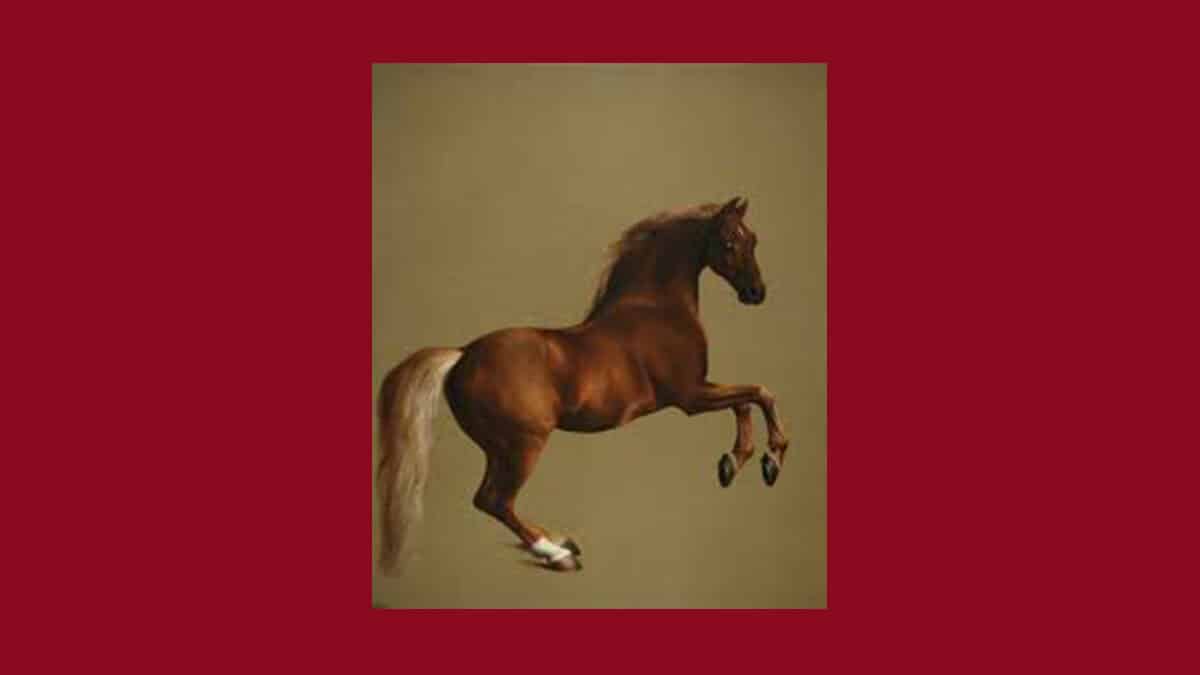This painting is one of the most famous portraits in the National Gallery. It’s a very life-like painting of a famous racehorse called Whistlejacket by an artist called George Stubbs!
Whistlejacket was born in 1749 and his most famous victory was in a race over 4 miles for 2,000 guineas at York in August 1759. Stubbs’s huge picture was painted in about 1762 for the 2nd Marquess of Rockingham, Whistlejacket’s owner, and a great fan of Stubbs’s artwork.
For as long as there have been horses, people have enjoyed riding and racing them, and this painting of Whistlejacket is a beautiful example. Whistlejacket was a very famous racehorse! He only lost four times in ten years on the turf! He was a beautiful chestnut thoroughbred stallion with a golden mane and tail.
George Stubbs painted this beautiful thoroughbred horse rearing up majestically on his hind legs. Unlike most paintings of the time which have very detailed backgrounds, the background of Whistlejacket is a very plain tan colour which makes the horse seem to leap out of the painting. It’s so realistic you can see the muscles and veins under the skin!
He’s a very popular painting and it’s easy to see why. Whistlejacket is nearly 3 metres tall! He’s even been hung in a special place so that you can see him down a really long corridor through 10 rooms.
There is a bit of a gruesome reason why George Stubbs could get very detailed paintings of horses, though. Stubbs was very interested in getting under the skin of his subjects – actually getting under the skin!
He lived in a farmhouse in France for a while with a large barn where he could study the bodies of dead horses. He would put the horses into poses and then peel back the skin and flesh all the way back to the skeleton. Yuck!
It may sound really gruesome, but it meant that Stubbs was able to make really detailed sketches of the anatomy of the horses. This is one of the reasons why his animal paintings look very realistic.
Stubbs wasn’t the only artist to use autopsies to get detailed drawings and studies of animals. Leonardo Da Vinci used to take out dead bodies from graveyards and dissect them to get really detailed anatomical studies and drawings! He actually made loads of really helpful scientific discoveries about the human body this way.
Have a go at painting your own life-like horse!
Can you imagine how you would create a life-like painting?
You may not want to do a dissection, but make sure you work as big as you can! George Stubbs used very large canvasses because it’s much easier to get very tiny details just right, so maybe your canvas will be a really big one, too!
How would you start?
Perhaps you would do a few smaller practise drawings first of different parts of the horse to get the tiny details right, and then you’d get bigger as you get more confident.
What pose would you choose for your drawing?
Maybe George Stubbs used this pose to show how powerful and lively Whistlejacket was. What pose would you have used and why?
How would you get the colours and textures so life-like?
Stubbs used oil paints to create his painting. Oils are very thick, oil-based paints that you can shape into different textures and mix using solvents called white spirit or turpentine instead of water. They’re also really easy to paint and blend on top of one another because they’re so thick, unlike paints like watercolours. But they take a long time to dry! Would you use oil paints too to get the right texture and colours?




